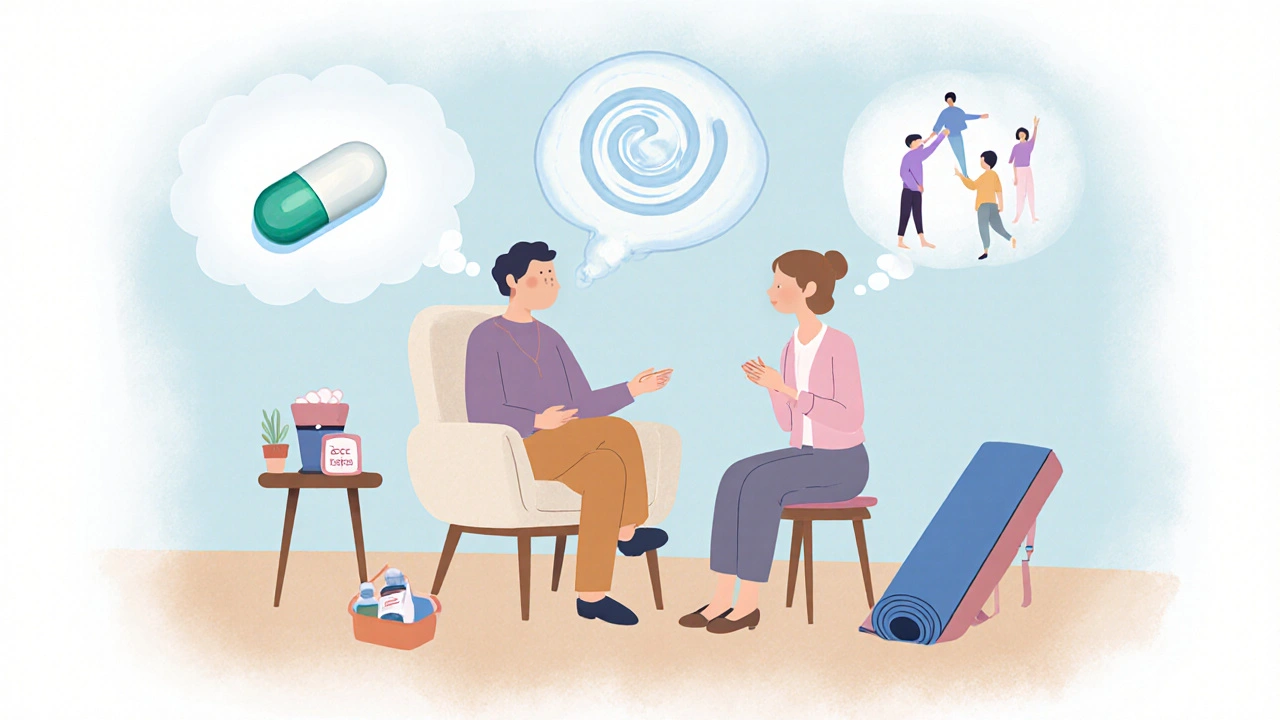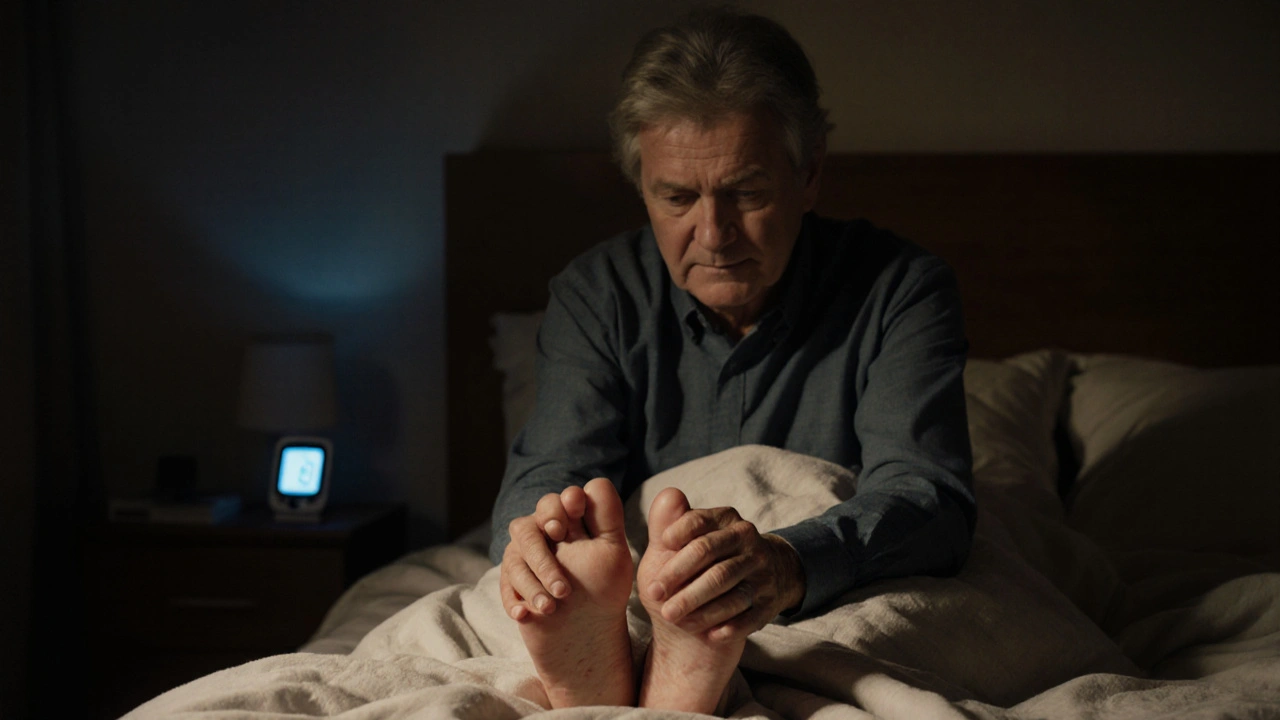When living with diabetic peripheral neuropathy is a nerve‑damage condition caused by long‑term high blood sugar, many people discover that the pain isn’t the only challenge. The numbness, tingling and burning sensations are hard enough, but the hidden emotional burden can feel just as crushing. Below you’ll find practical ways to recognize, understand, and manage that emotional toll so the condition doesn’t take over your life.
What makes the emotional side of diabetic peripheral neuropathy so tricky?
First, the physical symptoms constantly remind you that your body isn’t cooperating. Chronic pain often triggers stress hormones, which in turn can worsen blood‑sugar control. That loop makes it easy to slip into frustration or hopelessness. Second, the condition is invisible to most people; friends may not see the burning feet, so they can’t always grasp why you’re withdrawn.
Common emotional reactions
People with diabetic peripheral neuropathy report a mix of feelings that overlap with broader diabetes‑related mental health issues:
- Depression affects up to 30% of patients with chronic diabetic complications. Low mood can sap motivation to follow treatment plans.
- Anxiety often stems from fear of worsening symptoms or future amputations. Worry can keep you up at night, making pain feel worse.
- Feelings of guilt - you may blame yourself for ‘causing’ the nerve damage by not controlling blood sugar earlier.
- Social isolation - avoiding outings because of foot discomfort or embarrassment.
Spotting the warning signs early
It’s easier to act when you notice red flags before they turn into full‑blown depression or panic attacks. Look out for:
- Sudden loss of interest in hobbies you once loved.
- Changes in sleep patterns - either insomnia or oversleeping.
- Increased irritability or frequent arguments with loved ones.
- Persistent thoughts of self‑criticism, especially around diet or medication adherence.
If two or more of these appear for more than two weeks, consider reaching out to a professional. Early intervention can prevent longer‑term mental‑health setbacks.

Medical steps that protect both body and mind
Physical treatment and emotional wellbeing are tightly linked. Here’s what the latest guidelines (2024‑2025) suggest for the medical side of coping:
- Neuropathy medication such as duloxetine or pregabalin, not only dulls pain but also lowers anxiety scores in clinical trials.
- Blood glucose monitoring tight control reduces further nerve damage and stabilises mood by preventing glucose spikes that trigger irritability.
- Regular check‑ups with an endocrinologist to adjust insulin or oral therapy, which can lessen the unpredictability that fuels stress.
When medication eases the physical sting, the brain gets a break from chronic stress signals, making it easier to think positively.
Psychological coping tools that really work
Therapy is not a luxury; it’s a core part of a holistic neuropathy plan. Below are approaches with strong evidence for diabetes‑related emotional strain:
| Strategy | What it does | Typical Benefit | Time to See Results |
|---|---|---|---|
| CBT (Cognitive‑Behavioural Therapy) | Identifies negative thought patterns and replaces them with realistic alternatives | Reduces depression scores by ~40% in 12 weeks | 3‑4 weeks |
| Mindfulness‑Based Stress Reduction (MBSR) | Teaches present‑moment awareness, lowering pain‑related rumination | Improves sleep quality and cuts anxiety by 30% | 6‑8 weeks |
| Acceptance and Commitment Therapy (ACT) | Focuses on accepting pain while committing to valued actions | Boosts quality‑of‑life ratings even when pain remains | 4‑6 weeks |
Many clinics now offer tele‑therapy, making it easier to fit a session between blood‑sugar checks and work.
Lifestyle moves that lift the mood
Everyday habits can either add fuel to the emotional fire or help douse it. Try incorporating these:
- Physical therapy focused on gentle foot and ankle strengthening, improves circulation and releases endorphins. Even a 15‑minute daily walk can raise serotonin levels.
- Regular aerobic exercise - cycling, swimming, or brisk walking - lowers blood‑sugar spikes and releases mood‑boosting neurotransmitters.
- Balanced diet rich in omega‑3 fatty acids (salmon, walnuts) - research links these fats to reduced depressive symptoms.
- Join a support group for people with diabetes‑related nerve pain, either online or in‑person. Sharing experiences normalises feelings and provides practical tips.
- Sleep hygiene - keep a cool, dark room and limit caffeine after noon to avoid nocturnal pain flare‑ups that disturb rest.

Building your personal coping plan - a step‑by‑step guide
- Assess your emotional baseline. Use a simple scale (0‑10) to rate mood, pain, and anxiety each morning. Write the numbers in a notebook or app.
- Set realistic health goals. Choose one medical target (e.g., lower HbA1c by 0.5%) and one emotional target (e.g., practice mindfulness 10 minutes daily).
- Pick a primary therapy. If you feel stuck in negative thoughts, start CBT with a therapist who knows diabetes. If pain dominates, discuss neuropathy medication adjustment first.
- Schedule regular movement. Block a 20‑minute slot after lunch for a walk or gentle stretching. Consistency matters more than intensity.
- Connect weekly. Attend a diabetes support group meeting, either a local chapter in Sheffield or a reputable online community.
- Review and revise. Every two weeks, compare your mood‑pain scores to week‑one. Celebrate improvements, and tweak any strategy that isn’t moving the needle.
Writing the plan down makes it tangible, and checking it off reduces the sense of helplessness that often fuels emotional pain.
When to seek professional help
If you notice any of the following, it’s time to call a mental‑health professional or your diabetes care team:
- Thoughts of self‑harm or hopelessness.
- Sudden, severe mood swings that interfere with daily responsibilities.
- Inability to manage blood‑sugar levels despite following medical advice.
Many NHS trusts now have integrated diabetes‑mental health pathways, so you don’t have to start from scratch.
Frequently Asked Questions
Can antidepressants help with neuropathy pain?
Yes. Certain antidepressants, like duloxetine, are approved for diabetic neuropathic pain and often improve mood as a side effect. Always discuss dosing with your doctor.
Is it normal to feel angry about my foot pain?
Absolutely. Anger is a common response to chronic discomfort. Acknowledging it and channeling it into constructive actions-like joining a support group-can reduce its negative impact.
How much exercise is safe for someone with neuropathy?
Low‑impact activities such as walking, swimming, or stationary cycling for 150 minutes a week are generally safe. Start slowly, wear supportive shoes, and check skin daily for injuries.
Do support groups really make a difference?
Studies show that participants in diabetes‑related peer groups report lower depression scores and better medication adherence. Sharing tips also helps you discover new coping tricks.
What should I do if my mood suddenly drops after a pain flare‑up?
First, log the flare‑up and your emotions. Then try a rapid‑relief technique like 5‑minute deep‑breathing or a cold pack on the affected area. If the low mood persists for more than 48 hours, contact your care team.


Comments (15)
Angel Gallegos October 12 2025
Diabetic peripheral neuropathy is more than just a physical ailment; it infiltrates daily mood. Chronic pain constantly signals danger to the brain, keeping the stress axis activated. That persistent cortisol surge not only worsens glucose control but also erodes motivation. Recognizing the emotional feedback loop early can prevent a cascade into depression. One practical step is to keep a simple pain‑mood diary, rating each on a ten‑point scale. Correlating spikes with meals, activity, or stressors uncovers hidden patterns. In my experience, aligning medication adjustments with these patterns yields noticeable relief. Moreover, integrating a brief mindfulness routine-five minutes of focused breathing-has been shown to blunt pain‑related rumination. It is essential to pair that with regular low‑impact aerobic exercise, which promotes endorphin release and improves peripheral circulation. Even a daily 15‑minute walk, preferably on a soft surface, can shift serotonin levels enough to brighten outlook. Nutrition plays a supporting role; omega‑3 fatty acids from fish or walnuts have modest antidepressant effects in diabetic cohorts. Don’t overlook the power of peer support; a virtual group provides validation that the invisible nature of neuropathy often obscures. When isolation creeps in, schedule a weekly video call with someone who truly understands the struggle. Finally, seek professional help at the first sign of persistent low mood-two weeks of anhedonia or irritability merit a mental‑health referral. By treating the mind and the nerves as a unified system, you empower yourself to stay ahead of both pain and its emotional shadows.
ANTHONY COOK October 17 2025
Mindfulness really calms the nerve pain, give it a try. :)
Alfred Benton October 21 2025
The pathophysiology of diabetic peripheral neuropathy extends beyond the somatic realm, implicating psychoneuroimmunological pathways. It is a well‑documented fact that chronic nociceptive input sustains a hyperactive limbic system. Consequently, the resultant affective dysregulation may be misconstrued as mere psychological weakness. Such a misconception, however, serves the interests of those who choose to downplay the burden of chronic disease. Historical analysis reveals a pattern wherein pharmaceutical entities have subtly promoted medication as the sole solution, eclipsing psychosocial interventions. A critical appraisal of recent guidelines suggests an underemphasis on integrative care models. Therefore, patients should be vigilant and demand a balanced therapeutic plan that incorporates both pharmacologic and psychologic strategies. Ignoring this holistic approach may inadvertently perpetuate a cycle of suffering that benefits no one.
Kyle Salisbury October 25 2025
In many cultures, foot health is linked to overall well‑being, and that perspective can be therapeutic.
For example, Ayurvedic practices recommend daily foot massage with warm oil to improve circulation.
Such simple rituals not only stimulate blood flow but also provide a meditative pause.
Integrating these culturally rooted habits with conventional treatment can reduce the sense of alienation many patients feel.
Give them a try and you might notice a subtle lift in mood.
Angie Robinson October 30 2025
The emotional toll described here is accurate, yet the piece glosses over the socioeconomic factors.
The patients without access to affordable therapy often resort to self‑medication, leading to poorer outcomes.
Moreover, the suggestion to join support groups assumes internet connectivity and time availability.
A more realistic plan would address barriers such as transportation and insurance coverage.
Without that nuance, readers may feel blamed for circumstances beyond their control.
Consider adding resources for low‑cost community services.
Emmons Kimery November 3 2025
I totally agree, keeping a daily mood‑pain log can be a game‑changer.
It creates a concrete record that clinicians love to see.
📊 Plus, watching your own progress over weeks feels empowering.
Don’t underestimate the boost you get from a quick 5‑minute mindfulness break.
Your brain will thank you, and the pain often eases a notch.
Mimi Saki November 7 2025
You’re right, those breathing exercises are surprisingly effective.
🌟 Remember to sit comfortably, close your eyes, and inhale for four counts.
Exhale slowly, and repeat a handful of times when the tingling spikes.
Consistency is the secret sauce, even just a few minutes a day.
Keep at it, you’ll notice a calmer mind and softer sensations.
Subramaniam Sankaranarayanan November 12 2025
From a pathophysiological standpoint, the correlation between glycemic variability and central sensitization is well documented.
Therefore, any self‑monitoring tool should capture both glucose peaks and pain scores simultaneously.
I would also recommend integrating quantitative sensory testing to objectively assess nerve function.
Such comprehensive data sets enable clinicians to tailor pharmacologic regimens with greater precision.
abhishek agarwal November 16 2025
While the hidden agenda narrative is entertaining, the practical steps are what matter.
Patients should demand a multimodal plan that includes physical therapy and cognitive techniques.
Ask your endocrinologist about duloxetine, as it tackles both pain and mood.
And don’t forget regular foot inspections-early detection prevents infections.
Michael J Ryan November 20 2025
I’ve been juggling diabetes for years, and the emotional side often feels like a silent companion.
What helped me the most was a simple habit of writing down three things I’m grateful for each morning.
It shifts focus away from the pain and restores a bit of perspective.
Coupled with a short walk after dinner, my blood sugar levels have become more stable too.
If you’re hesitant about therapy, try a free online CBT module; many platforms offer a trial period.
The techniques teach you how to reframe catastrophizing thoughts into manageable actions.
Remember, small consistent steps beat occasional grand gestures.
Khalil BB November 25 2025
Reframing thoughts is a core CBT skill; it directly reduces pain‑related anxiety. Keep it short and repeat daily for best results.
Keri Shrable November 29 2025
Wow, this post is a rainbow of practical gold!
I love the way it stitches together meds, movement, and mind‑games.
The table of therapies reads like a menu at a fancy restaurant-pick what tastes right for you.
And the step‑by‑step plan feels like a treasure map leading to brighter days.
Grab a pen, chart your own course, and watch the gloom melt away.
Destiny Hixon December 3 2025
this is lit dont u think
mike brown December 8 2025
I see a lot of hype around mindfulness, but let’s be real-it’s not a miracle cure.
Most studies cherry‑pick participants who already have low stress, inflating the results.
If you’re looking for concrete relief, you need something that targets the nerve fibers directly.
Medication adjustments and proper footwear often get overlooked in favor of feel‑good fluff.
Don’t let the wellness industry sell you an expensive yoga mat as a pain solution.
Stick to evidence‑based interventions and you’ll see real progress.
Stephen Jahl December 12 2025
Your reductionist view neglects the biopsychosocial model which undergirds contemporary neuropathic pain management.
Empirical data from randomized controlled trials corroborate the synergistic efficacy of pharmacotherapy combined with mindfulness‑based interventions.
Thus, discarding the latter constitutes a categorical error in therapeutic optimization.
Furthermore, the econometric analyses demonstrate cost‑effectiveness when integrative modalities are employed.
I recommend revisiting the literature to calibrate your clinical heuristics accordingly.